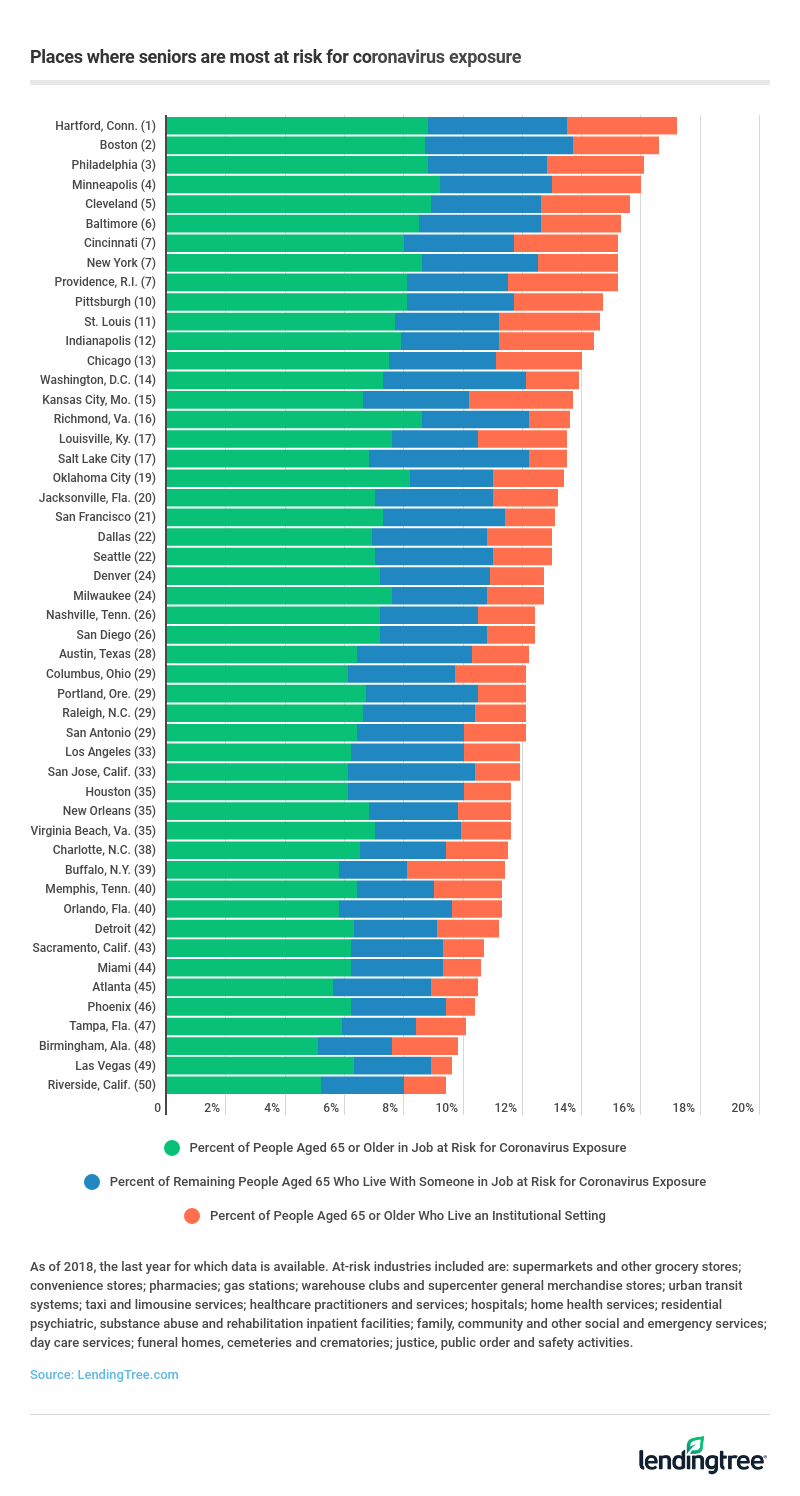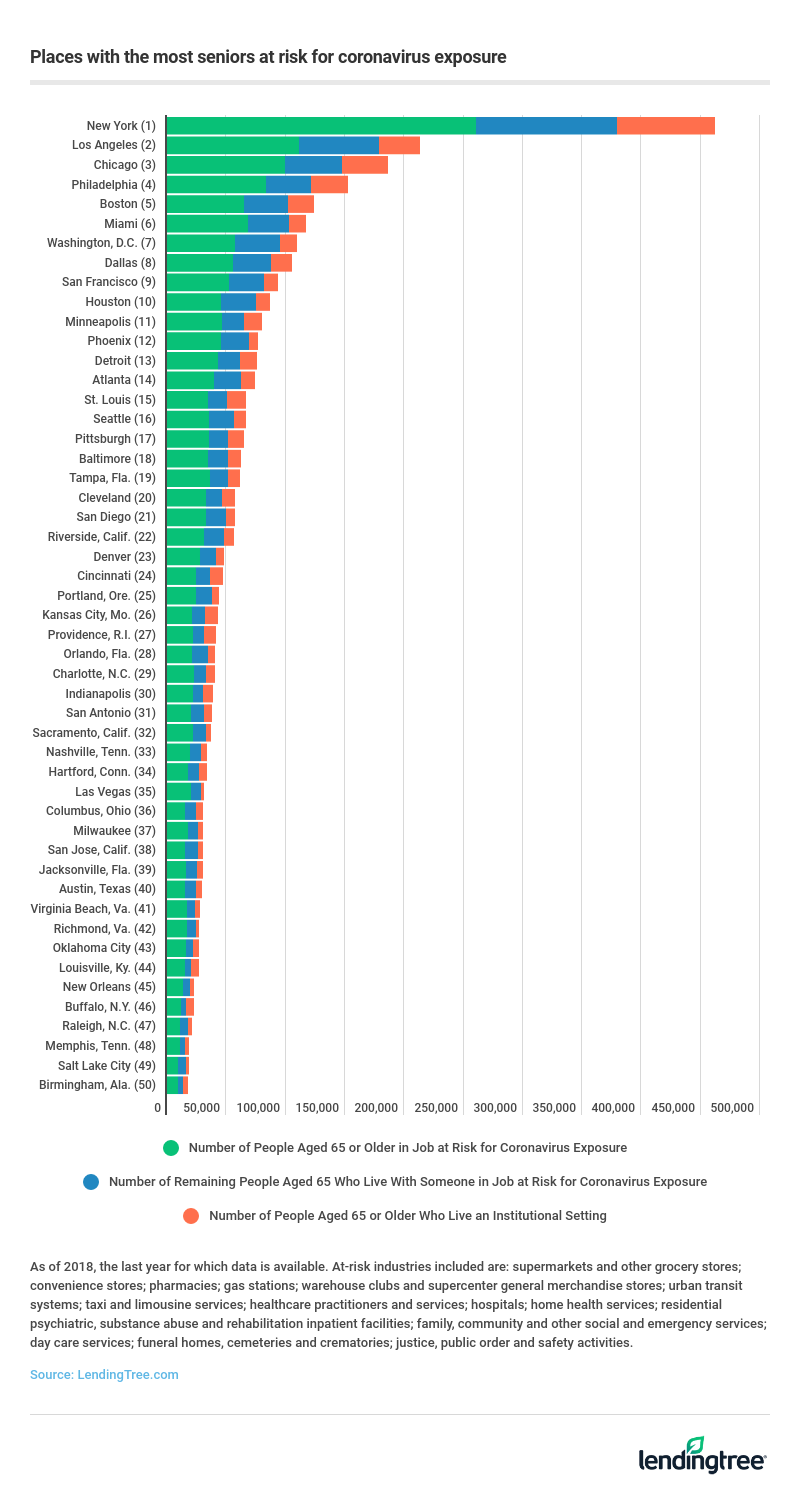Where Seniors Are Most at Risk of Coronavirus Exposure
The novel coronavirus is a danger to anyone who catches it, but it’s particularly deadly for seniors. Eight out of 10 coronavirus deaths in the U.S. have been in adults ages 65 and older, according to the Centers for Disease Control and Prevention (CDC). Ideally, all Americans who are at a higher risk of serious complications from COVID-19 would stay isolated from the rest of the population, but that’s just not possible. Many American seniors work well into retirement age, and others live with people who work in public-facing occupations.
To determine the metropolitan statistical areas (MSAs) where seniors are most at-risk of being exposed to the coronavirus, LendingTree analyzed three data points from the 2018 American Community Survey: the percentage of seniors who work in jobs that put them at risk of catching the virus; the percentage of seniors who live with people who work in those high-risk jobs; and the percentage of seniors who live in institutions.
Key findings
- Hartford, Conn., has the highest rate (17.2%) of people aged 65 or older at risk of exposure. In Hartford, 8.8% work in a risky industry, 4.7% live with someone who does and another 3.7% live in an institution.
- Boston follows just behind with 16.6% of seniors at risk: 8.8% work in a risky setting, 5% live with someone who does and 2.9% are in an institutional setting. Philadelphia has 16.1% of seniors at risk, while Minneapolis has 16.0%.
- Riverside, Calif., has the lowest rate (9.4%) of seniors at risk. Las Vegas and Birmingham, Ala., follow with 9.6% and 9.8%, respectively.
- Unsurprisingly, the largest American metros have the highest count of seniors at risk. 462,188 senior residents in New York were identified as being at risk, followed by 213,161 in Los Angeles and 186,107 in Chicago.
- In Minneapolis, 9.2% of seniors work in a risky industry, the highest of any metro we reviewed. Birmingham, Ala., sits at the other of the spectrum, with a rate of 5.1%.
- Salt Lake City has the highest rate of seniors living with someone who works in a risky industry, at 5.4%. Only 2.3% do in Buffalo, N.Y., the lowest rate in that category.
- Hartford, Conn., and Providence, R.I., tie for the highest rate of seniors living in institutions at 3.7%. Las Vegas has the lowest rate at 0.7%.
Seniors in the Northeast are most at-risk of exposure to the coronavirus
As a whole, seniors in Northeastern metros are worse off than seniors elsewhere in America when it comes to the risk of exposure to the coronavirus. The top three metros — Hartford, Conn., Boston and Philadelphia — are all in this region. Two Pennsylvania metros, Philadelphia and Pittsburgh, rank in the top 10.

In all of the top 10 metros, more than 8% of the senior population works at a job with a higher risk of COVID-19 exposure, such as nursing or transportation. Employees in public-facing jobs such as these are considered essential workers and can’t follow social distancing protocol, which slows the spread of the coronavirus. Five percent of Boston’s senior population lives with someone who works at a job that has a higher risk of exposure.
Hartford, Conn. and Providence, R.I., (tied for 7th) both have the highest proportion of seniors in an institutionalized setting like a nursing home or prison, at 3.7% each. One of the first COVID-19 outbreaks in the U.S. was in a Washington state nursing home in early March. Inmates at Rikers Island, a New York City jail, struggle to protect themselves from the coronavirus.
Select Midwestern metros also rank high, although it’s not a rule
| Rank | Metro | Percent of People Aged 65 or Older in Job at Risk of Exposure | Number of People Aged 65 or Older in Job at Risk of Exposure | Percent of Remaining People Aged 65 Who Live With Someone in Job at Risk of Exposure | Number of Remaining People Aged 65 Who Live With Someone in Job at Risk of Exposure | Percent of People Aged 65 or Older Who Live an Institutional Setting | Number of People Aged 65 or Older Who Live an Institutional Setting |
|---|---|---|---|---|---|---|---|
| 1 | Hartford, Conn. | 8.80% | 17,458 | 4.70% | 9,187 | 3.70% | 7,371 |
| 2 | Boston | 8.70% | 64,580 | 5.00% | 37,660 | 2.90% | 21,902 |
| 3 | Philadelphia | 8.80% | 83,500 | 4.00% | 38,054 | 3.30% | 30,755 |
| 4 | Minneapolis | 9.20% | 46,056 | 3.80% | 18,936 | 3.00% | 15,078 |
| 5 | Cleveland | 8.90% | 32,585 | 3.70% | 13,502 | 3.00% | 10,960 |
| 6 | Baltimore | 8.50% | 34,856 | 4.10% | 16,741 | 2.70% | 10,994 |
| 7 | Cincinnati | 8.00% | 24,646 | 3.70% | 11,398 | 3.50% | 10,905 |
| 7 | New York | 8.60% | 260,651 | 3.90% | 118,425 | 2.70% | 83,112 |
| 7 | Providence, R.I. | 8.10% | 22,128 | 3.40% | 9,204 | 3.70% | 10,145 |
| 10 | Pittsburgh | 8.10% | 35,631 | 3.60% | 15,775 | 3.00% | 13,160 |
Midwestern metros like Minneapolis (4th) and Cincinnati (tied for 7th) have a high proportion of seniors at risk of the coronavirus. In particular, two Ohio metros — Cincinnati and Cleveland (5th) — rank in the top of the list. Three other Midwestern metros just missed the cut for top 10: St. Louis (11th), Indianapolis (12th) and Chicago (13th).
However, some other Midwestern metros, like Detroit (42nd) and Columbus, Ohio (tied at 29th), fare a bit better. In general, seniors who live in metros in western and southern states stay safe at higher proportions than in the other regions.
Big metros have the highest numbers of at-risk seniors

While big metros like New York and Los Angeles have a smaller proportion of at-risk seniors than other metros like Hartford, Conn., they do have a higher number of seniors who are at risk of being exposed to the coronavirus.
Some metros, like Boston, unfortunately rank high for the number of at-risk seniors (5th) and the proportion of at-risk seniors in their community (2nd). Similarly, New York has the highest number of at-risk seniors and ranks 7th in a tie for the proportion of at-risk seniors within their community.
Although Hartford, Conn. has the highest proportion of seniors who are at risk of coronavirus exposure, it ranks 34th for the number of seniors who are at risk. For comparison, New York has 462,188 seniors who are at risk, while Hartford has just 34,016.
Social isolation doesn’t stop everyone from working — even seniors
Governments at the local, state and federal levels are taking steps to prevent the spread of the coronavirus. Most states have issued stay-at-home orders that forbid non-essential travel outside the home, although four states (Arkansas, Iowa, Nebraska and North Dakota) don’t have such measures in place, as of April 8, 2020.
Even with these stay-at-home orders and social distancing policies in place, workers who are deemed essential are still required to report to work. You can find more examples of essential occupations we listed in our methodology, but some examples include:
- Pharmacists and drugstore workers
- Transit service workers (bus drivers, taxi drivers)
- Hospital workers, such as nurses and doctors
- Grocery store and hardware store workers
- Funeral home workers
Employees who are still required to work during the COVID-19 pandemic are encouraged to wear face coverings, like a mask, as well as gloves. However, many of these supplies are in such high demand that not all employers can provide them and not all employees can purchase them for use at work. And for some employees, staying at home isn’t an option — you either come to work, or you don’t get paid.
Seniors should stay home, but they have bills to pay
The best way to stop the spread of the coronavirus is to stay at home and avoid contact with other people. Many workers are fortunate enough to be able to work from home during the outbreak, but not everyone is so lucky.
Some Americans, including some seniors, need to go to work so they can pay down bills and debt. According to a February 2020 LendingTree study, seniors in the 65 to 70 age group carry an average of $22,471 in non-mortgage debt.
Borrowers who can’t pay their loans, such as mortgages, personal loans or auto loans, are encouraged to contact their lenders to see if they have any hardship assistance programs in place. Some banks and lenders are waiving late fees and offering forbearance for borrowers who are out of work due to COVID-19.
If you’re struggling to make ends meet during the coronavirus pandemic, check out the LendingTree coronavirus guide for tips and advice on how to manage your finances.
Methodology
Using microdata from the U.S. Census’ 2018 American Community Survey hosted by IPUMS (last year available), analysts calculated the number of people aged 65 or older in each of the 50 largest American metros who either worked in an industry identified as risky because of its essential nature and high exposure to the public, lived with someone else who worked in one of those industries or lived in a institutional setting.
Institutions include correctional institutions, mental institutions and institutions for the elderly, disabled, handicapped and poor. No one identified as living in non-institutional group quarters (e.g., dormitories and barracks) was included.
An individual can only appear in one of the three categories. The percentage of people aged 65 or older in each metro was calculated for each category of risk.
Identified industries followed by NAICS codes are:
| Bus service and urban transit 6180 | Offices of dentists 7980 |
|---|---|
| Child day care services 8470 | Offices of optometrists 8070 |
| Community food and housing, and emergency services 8380 | Offices of other health practitioners 8080 |
| Convenience stores 4972 | Offices of physicians 7970 |
| Funeral homes, and cemeteries and crematories 9080 | Other health care services 8180 |
| General medical and surgical hospitals, and specialty (except psychiatric and substance abuse) hospitals 8191 | Outpatient care centers 8090 |
| Gasoline stations 5090 | Pharmacies and drug stores 5070 |
| General merchandise stores, including warehouse clubs and supercenters 5391 | Psychiatric and substance abuse hospitals 8192 |
| Home health care services 8170 | Residential care facilities, except skilled nursing facilities 8290 |
| Individual and family services 8370 | Supermarkets and other grocery (except convenience) stores 4971 |
| Justice, public order and safety activities 9470 | Taxi and limousine service 6190 |
| Nursing care facilities (skilled nursing facilities) 8270 | Vocational rehabilitation services 8390 |
Get personal loan offers from up to 5 lenders in minutes
